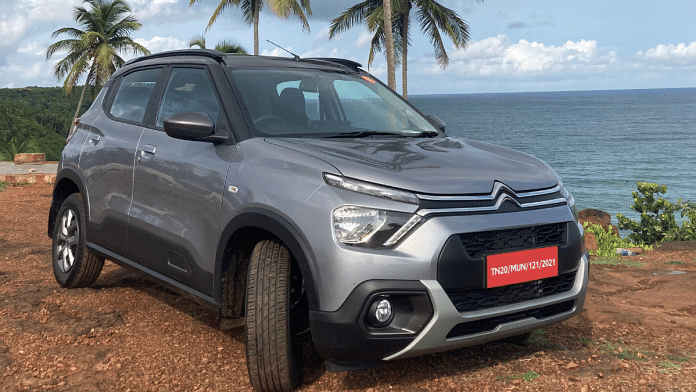Recently, I found the Citroen C3 turbo at my house in CR Park in Delhi. And while I had reviewed the car when the French carmaker launched it in Goa, driving a vehicle in its natural habitat — an urban megapolis — is the best way to evaluate how living with it feels like. So, it was a fun car to drive whenever you found an empty stretch of road to give the turbocharger a workout, which, during the day, in Delhi-NCR, is almost impossible. Coupled with the fact that the C3 lacks an automatic transmission, which is increasingly a necessity in places like NCR, it was not always enjoyable.
But an automatic is not the only thing the C3 lacks. The fact that there are no electrically adjustable outside mirrors or prismatic night setting on the inside rear-view mirror is downright irritating. Sure, the car comes with a lovely high-definition screen for the infotainment system, but weirdly lacks a reverse camera as a standard fitment. Citroen says you can get it as an option but carmakers are mandated to have reverse parking sensors on all cars now. Even the Maruti Suzuki Alto has a reverse camera as a standard in its top model.
And as useful as reverse sensors are, nothing quite beats a reverse camera. I know the warnings about not trusting the camera solely are there on all cars, but, usually, when I reverse a car, I stare intently at the reverse camera display on the infotainment screen. It sure is a lot less physically strenuous than twisting your torso and turning your head over your shoulder. This, along with the reverse sensors whose beeps you get accustomed to, including the loud shrill just before you hit something, has spoiled me.
Also read: Bike, auto, jaywalker, beep beep—why ADAS will soon make your car behave like a plane
Comfort features made you lazy
Honestly, it was not like this in the past. I learnt how to drive in the mid-1990s on a Maruti van — as the Omni was called back then — and that did not even have an air conditioner. Today, driving aids and creature comforts have become pervasive. I remember experiencing power windows for the first time on a Mercedes owned by a friend’s father, and it felt like magic. Even when my father acquired his first car with power windows — a Maruti Esteem VX in 1996 — that singular feature made one agape.
My first car, a Maruti-Suzuki Alto, which I bought in 2002, had no power windows. It had power steering and an air conditioner but no reverse sensors. Nor did the Hyundai i20 I got in 2009. But in the early 2010s, reverse sensors and cameras started filtering down from the luxury segment onto mass-market cars. And as someone who changes cars far too frequently, it changed how I drive or, at least, reverse. Frankly, it made me lazy.
I was someone who could reverse in the tight and twisty lanes of CR Park, often having to reverse out a couple of hundred meters down an entire lane and do that using mirrors. But a few years ago, when Maruti Suzuki invited me to try out the computerised driving centre in Delhi’s Sarai Kale Khan Regional Transport Office (RTO), they bunged me in an old WagonR and I had to reverse down an ‘S’ bend without touching the sidewalk. No sensors, and no camera, but it had all three mirrors. And I failed the first time. Of course, failure is not an option when it comes to something through which I earn my daily bread, so I went again. And passed.
But that experience taught me something — how lazy I’d become and, I assumed, many others may have as well. Look at another basic driving habit that we used to be taught once upon a time: Do not brake on turns. The inside wheel could lock up and you could easily get into a spin. However, today, cars have anti-lock braking systems (ABS), and while you could still lock up, you have to try hard to do it. Most of the time nowadays on any modern car, you can brake while turning and the vehicle won’t even complain by vibrating.
Forget automatic transmissions — which are becoming very common, and rightly so — you have automatic headlights and wipers as well. The latter still freaks me out, but now, with advanced driver assistance systems (ADAS), the brakes will be applied automatically if the car senses a potential collision. And the brakes are so hard that you feel like you have indeed had a collision.
Sure, certain creature comforts are nice, even useful. Hyundai and Kia cars have been coming with automatic air purifiers with a PM2.5 display, which is an extremely useful feature these days in North India. Although, many of these features, like the multicolour LED cabin lights, while fantastic, are gimmicky. But you get used to them, just like you have with power windows. I’m sure if you showed wind-up windows to a teenager used to modern cars, they’d be shocked.
And that is the same thing with reverse cameras — you have become so used to them that you notice if a car doesn’t have them. And as a car evaluator, you ask a simple question: Why? It isn’t as if camera sensors are expensive, and this was the top-end C3 Turbo that costs Rs 8.5 lakh (ex-showroom). Even an 8,000-rupee smartphone has multiple cameras. Sure, the car drives well, but often, it is just a singular thing that puts you off it or any product for that matter. And, by the tone of this column, you must have guessed by now, that the lack of a reverse camera, and not the broken smartphone USB connector the review car came with, did that for me.
@kushanmitra is an automotive journalist based in New Delhi. Views are personal.
(Edited by Humra Laeeq)



